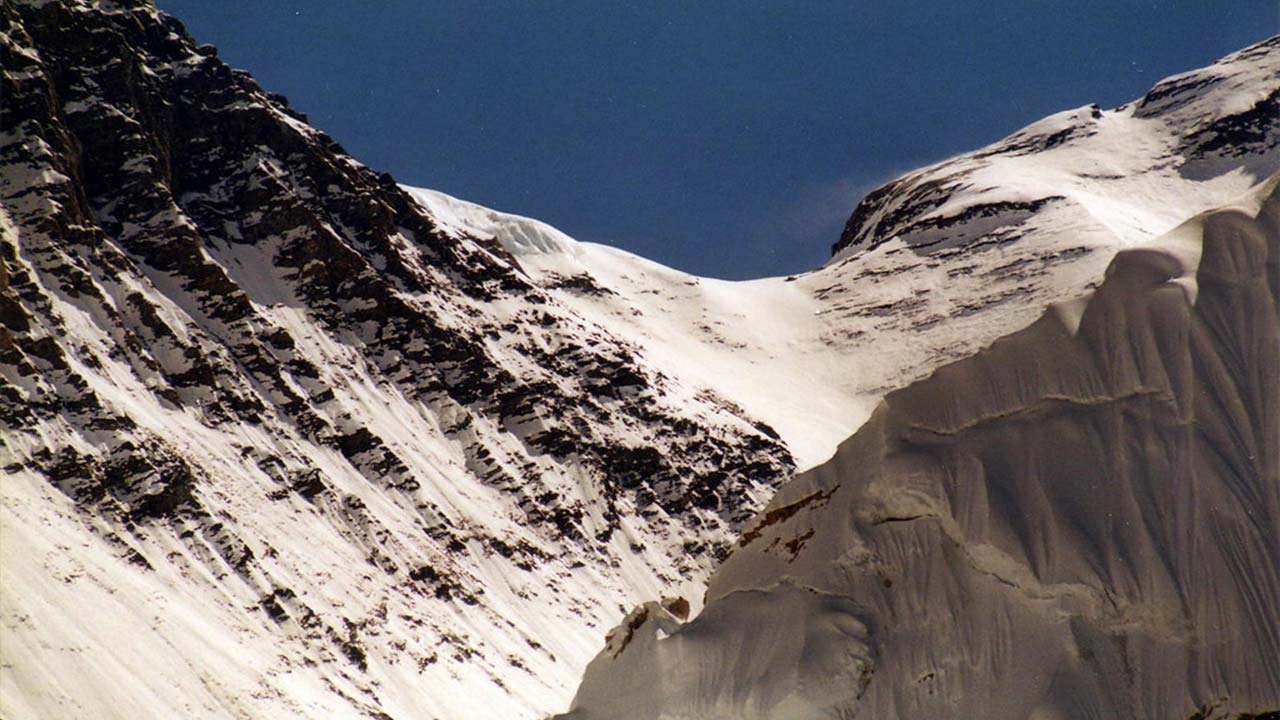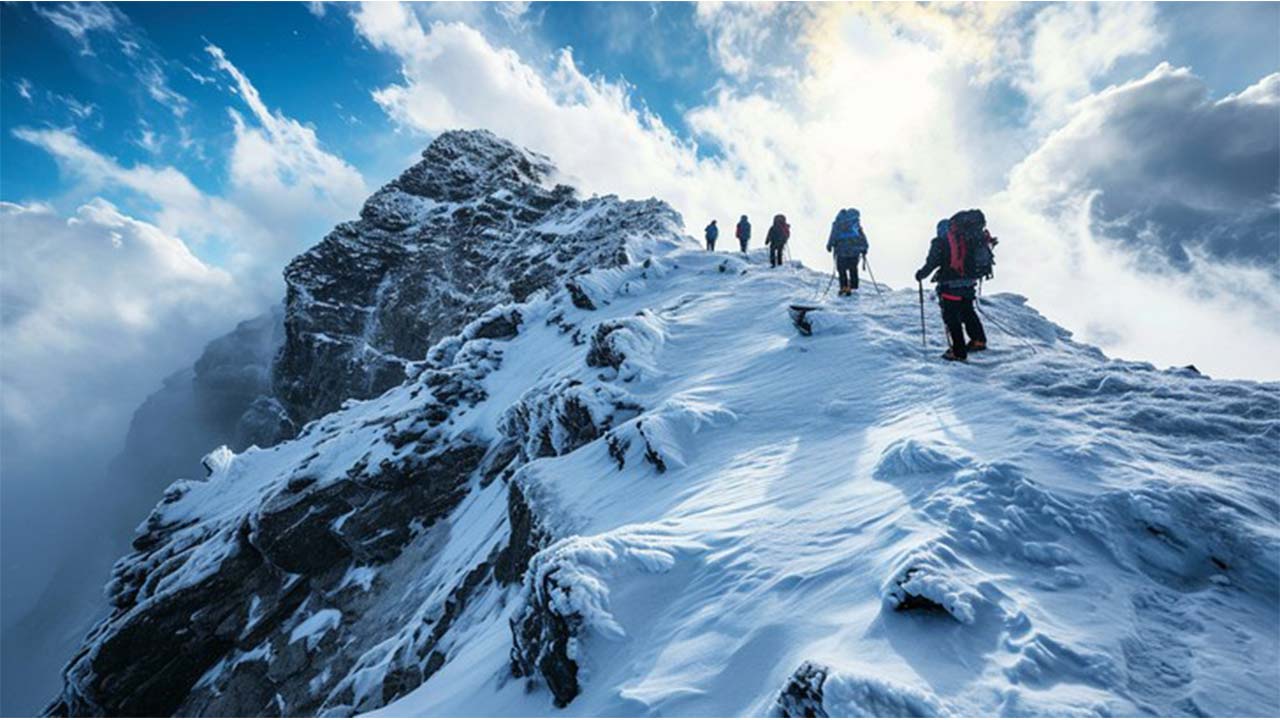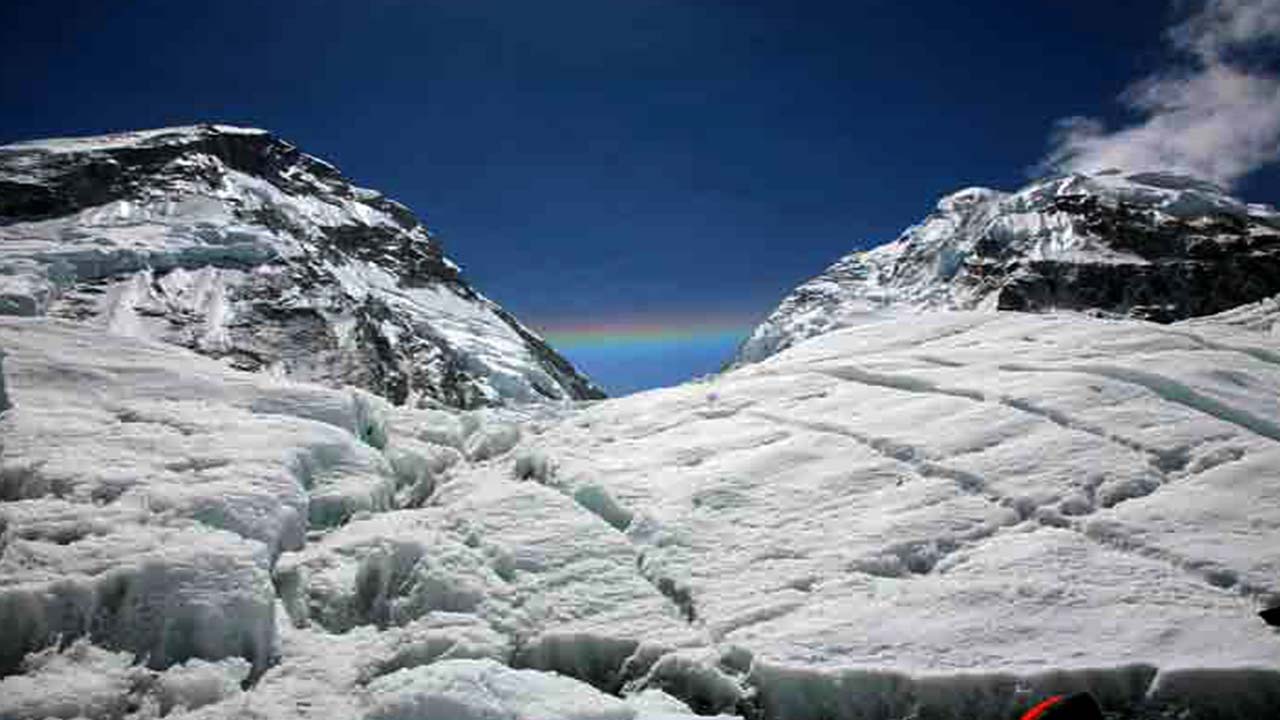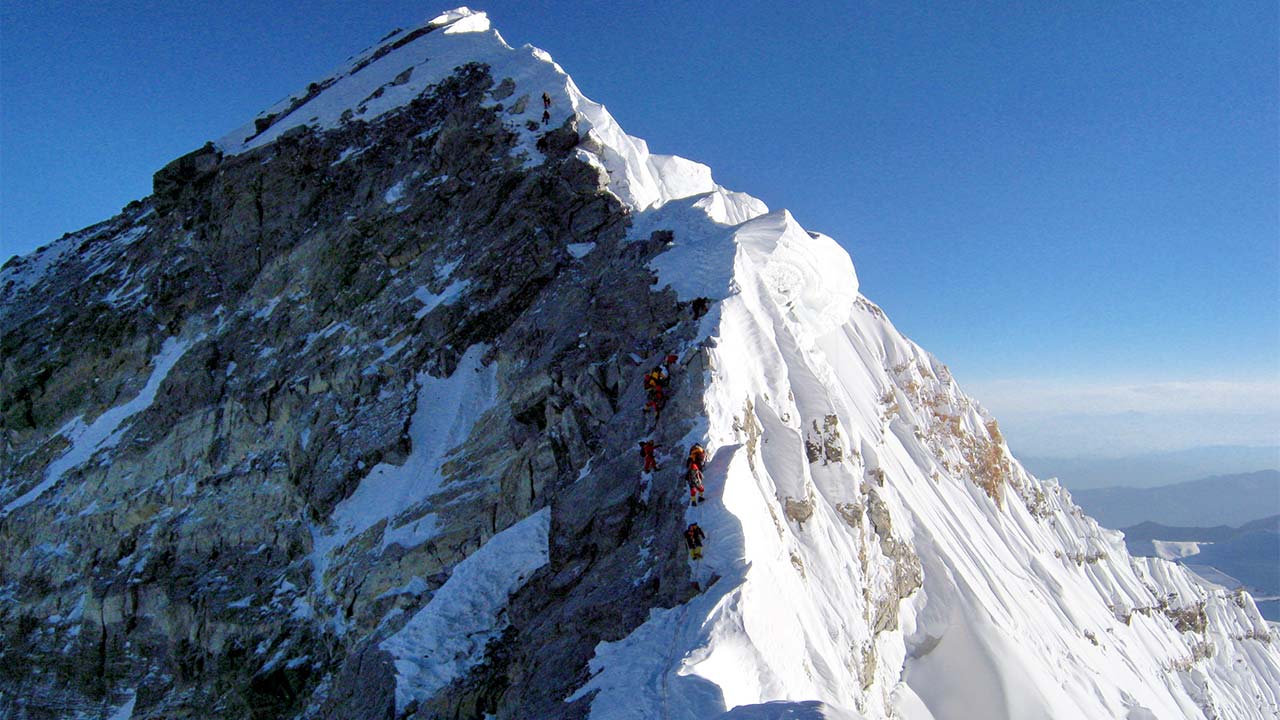High above the swirling clouds and the jagged ridges of the world’s tallest mountain lies a realm unlike anywhere on Earth. The ‘Everest Death Zone’, a stretch that lies above 8,000 meters (26,246 feet), where air is too thin, the cold too biting and the weather too unpredictable for sustained survival. At this altitude, the atmosphere only contains about one-third of the oxygen found at sea level, making it impossible for the human body to function normally for a long period.
Inside Mt Everest Death Zone, every breath is labored, muscles weaken rapidly due to oxygen deprivation and even the simplest movements demand enormous effort. Climbers here are constantly on the edge of exhaustion, nattling not just cold and wind but the basic fight to stay conscious and keep moving forward. This is also the section on the mountain where the risk multiples. The lack of oxygen can cause confusion, poor judgment and slowed reaction times, all of which make it harder to make critical decisions when every second matters.
The life-threatening conditions like High Altitude Cerebral Edema (HACE) or High Altitude Pulmonary Edema (HAPE) can also strike quickly. And, with the rescue operation extremely difficult at these altitudes, survival depends almost entirely on self-reliance and the support from one’s team. The Death Zone of Mount Everest is the final barrier between the climbers and the summit of the world’s highest peak. Here, there is no margin for error and every climber must carefully manage their energy, monitor their health and perfectly time their summit attempt with precision.
Spending too much time inside the death zone can be fatal. That’s why even the most experienced climbers approach it with extreme caution. This treacherous section of the mountain has claimed many lives, yet continues to draw climbers from around the world, drawn by the challenge, glory and the personal test it represents.

What is the Death Zone on Mount Everest?
In the mountaineering world, the term ‘Death Zone’ refers to the segment on the mountain above 8,000 meters (26,246 feet). There are only 14 peaks on the entire planet that rise above 8,000 meters and all of them have death zones. Depending on the total elevation and terrain, the risk inside the death zone can differ from mountain to mountain. At these majorly elevated sections of the 8,000-ers, the air becomes so thin that human life can only be sustained for a limited period of time.
On Mount Everest, the highest peak of them all, at an elevation of 8,848 meters (29,029 feet), this deadly threshold begins a few hundred meters. Well, as the tallest peak standing on the planet, it is natural to be curious about how long is the Death Zone on Mount Everest. The answer, all the area above 8,000 meters, i.e., approximately 848 meters (2,782 feet), length of the mountain is inside the death zone . Climbers need to navigate this section while scaling to the summit. And, the environment inside the Everest Summit Death Zone is so hostile that every second spent there gradually starts to shut down the human body.
At sea level, the atmosphere has roughly 21% oxygen, which is more than enough for our bodies to function normally. However, as you start ascending to the higher elevation, the atmospheric pressure starts to drop and there are fewer oxygen molecules. Inside the Mount Everest Death Zone, the oxygen level in the atmosphere is about one-third of what it is at sea level. As the oxygen pressure is so low, your lungs can’t transfer enough oxygen to your bloodstream, no matter how deeply or quickly you breathe. As a result:
- The cognitive functions start to decline: decision-making quality is impaired
- Physical strength plummets: muscles weaken as you burn energy faster
- Cell damage accelerates: gradually, vital organs begin to fail due to prolonged oxygen deprivation
- Risk of HACE and HAPE skyrockets: the severe forms of altitude sickness can strike suddenly and are often fatal
So, to sum it up, the Everest Death Zone is not just a location on the mountain; it is a stretch where the human body begins to shut down gradually. Here, the survival is measured in hours, not days, and there is a razor-thin line between error and fatality.
Where is the Death Zone on Mount Everest?
So, when the climbers talk about the Death Zone of Mount Everest, they are not referring to a particular fixed point on the mountain. But, rather a high-altitude band that begins above 8,000 meters and extends all the way to the summit of the mountain, 8,848 meters. This deadly altitude zone is present on both sides of the mountain: South (Nepali side) and North (Tibetan side). So, the exact entry point of the Everest Death Zone depends on which side of the mountain you are climbing from.
Where Does the Death Zone Start on Mount Everest?
- On the South Route (Nepal): The Mount Everest Death Zone begins just above Camp IV (7,950m/ 26,082ft) at the South Col on the Nepali side. From here, the mountaineers follow the Southeast Ridge and pass the landmarks like Balcony, South Summit and finally Hillar Step before pushing for the true summit.
- On the North Route (Tibet): Climbers taking the northern route enter the Everest Death Zone (Rainbow Valley) after leaving Camp III , approximately around 8,300 meters (27,230 feet). The climbing route then stretches across First Step, Second Step and Third Step before ascending to the final summit ridge.

In both cases, the death zone encompasses the final vertical climbing section where oxygen levels plummet to just one-third of sea-level capacity and the survival period without supplementary oxygen is extremely short. In case if you were to look into the Mt Everest Death Zone Map, you will see this section on the mountain as a narrow and high-altitude strip that hugs the pyramid-shaped summit.
Temperature in Everest Death Zone
To put it in simpler words, the temperature in the Everest Death Zone is as brutal as its oxygen-starved air. At altitudes above 8,000 meters, where the Mount Everest Death Zone starts, the environment is dominated by extreme cold, violent winds and rapid weather shifts that can turn an expedition from challenging to lethal in minutes. On average, the temperature in Everest Death Zone ranges around -20°C to -30°C during the climbing seasons (spring and autumn).
However, sometimes the wind chill can push the temperatures well below -40°C. Under such circumstances, frostbite can occur under 10 minutes and hypothermia is a constant threat for even climbers with the best gear. So, you might be wondering why cold in death zone is deadlier than elsewhere? Well, the answer lies in the extreme altitude physiology. Due to a lack of sufficient oxygen in the atmosphere, your body burns more energy just to keep you warm. Even with the high-tech down suits, the heat loss is rapid.
Once the body temperatures start to drop, both physical and mental performance collapse quickly. Thus, in conclusion, the temperature in Everest Death Zone is not just low, it is lethally low. During the expeditions, climbers face a constant battle against the cold that can sap their strength, cloud their judgements and tip the balance between life and death, all in a matter of minutes.
Mount Everest Death Zone Weather
The Death Zone of Mount Everest is not just a place with low oxygen levels and freezing temperatures that can be fatal. But it is also one of the most unpredictable and dangerous weather zones on the planet. It kinda makes sense, after all, it is the highest point on the planet. At altitudes above 8,000 meters (26,246 feet), the atmosphere is so thin that it cannot slow sudden changes in weather.
This means that blue skies can turn into a whiteout blizzard in less than an hour and the steady wind can transform into a hurricane-force gust without any warning. Likewise, the blizzard, snowdrifts and fog can obscure the route markers, which makes navigation challenges increase the risk of falls or getting lost. The bad weather inside the Everest Death Zone is directly related to some of Everest’s deadliest disasters. Sudden storms have trapped the expeditioners high on the mountain, forcing them to spend extra hours or an unplanned night inside the death zone, which drastically increases the fatality risk.
In such cases, oxygen supplies run out, body heat plummets and the frostbite sets in quickly. Historical tragedies like the 1996 Everest disaster highlight how the weather can turn a summit day into a life-or-death struggle in just a few hours. On 10th May 1996, a severe blizzard struck Mount Everest, which hit four different expedition teams on the mountain, claiming the lives of 8 climbers.
Bodies in Everest's Death Zone
The bodies in Everest's Death Zone are the haunting reminder of how unforgiving the mountain can be. Above 8,000 meters, the air is too thin, the weather is too unpredictable and the terrain is too treacherous for most recovery efforts. Which is why many climbers who take their last breath on the mountain are never brought down, turning parts of the Death Zone of Mount Everest into a frozen graveyard. Trying to recover these Everest dead bodies from the mountain is an extreme and dangerous undertaking.
At such an altitude, every step requires immense physical effort. And carrying additional weight, especially 80 to 100 kg (176 to 220 lbs), of the frozen climb can be life-threatening. Here are the factors that can make the Everest Death Zone rescue/recovery so rare:
- Thin Air and Human Limits: Even with supplemental oxygen, climbers have to operate at the edge of human endurance.
- Risk to Rescuers: Attempting to recover the body from the Everest Summit Death Zone means exposing the rescue teams to the same lethal conditions that can be fatal.
- Cost and Logistics: Organizing a retrieval mission can cost thousands of dollars and requires highly skilled Sherpas willing to take the risk.
- Frozen Terrain: Many Mount Everest Death Zone bodies are encased in ice or wedged into mountain crevasses, which sometimes makes the removal nearly impossible without specialized equipment.
Due to this, around 200 bodies still remain on the slope of Mount Everest. Many of these Everest dead bodies are just lying off the main climbing route, where they are visible to every climber attempting to push for the summit. Among many, Francys Arsentiev ‘Everest Sleeping Beauty’ and Tsewang Paljor ‘Everest Green Boots’ are two notable cases in the Everest Death Zone. Though recent efforts have moved or covered several of the dead bodies to preserve their dignity and reduce the psychological impact on the climbers.
If you plot a Mount Everest Death Zone map, most bodies of the climbers are found along the South East Ridge above the South Col on the Nepali side. Similarly, most fallen climbers lie on the North East Ridge above the North Col on the Tibetan side. Clusters occur near the difficult technical sections on both sides of the mountain, like Hillary Step and Second Step. Here, the combination of exhaustion, altitude sickness and unpredictable weather can often be fatal.
In many ways, the bodies in Everest’s death zone are not just tragedies. They are warnings, silent and stark, that remind every climber inside the death zone, nature shows no mercy and mistakes are rarely forgiven.

Surviving Mt Everest Death Zone
Surviving the Everest Death Zone above 8,000 meters is not about conquering the mountain slope. But it is about outlasting one of the harshest environments on Earth for just long enough to get back down alive. Inside this deadly section on the mountain, every heartbeat, every breath and every step is a fight against time, oxygen starvation and the high-altitude alpine elements. Success rate inside the death zone depends on preparation, discipline and the ability to make hard decisions when they matter most.
- Supplemental Oxygen: This is the single most important tool for survival inside the Mount Everest Death Zone; it is literally a lifeline above the clouds. While the oxygen bottles don’t eliminate the dangers, it does raise blood oxygen saturation, delay the onset of hypoxia and keep the brain and muscles functioning longer.
- Acclimatization: Proper acclimatization before entering the Everest Summit Death Zone can mean the difference between life and death. Climbers typically follow the ‘climb high, sleep low’ strategy during the expedition. Spending several weeks ascending to higher camp and returning to altitude rest allows red blood cells to carry oxygen more efficiently to high elevation with low atmospheric pressure.
- Summit Timing: Inside the Mt Everest Death Zone, good judgment means survival. Climbers have to rely on strict timing to avoid prolonged exposures. Most climbing teams leave Camp IV around midnight to reach the summit by early morning. There is also a 2 o’clock rule on Mount Everest, climbers need to abandon their summit attempt by this period to avoid being caught in worsening weather and darkness.
On the highest peak in the world, surviving the Death Zone is not just about physical strength. But it is also about knowing when to walk away from the summit to live another day and try again. Climbers who make it back alive often do so because they respect the mountain’s limit as much as their own.
Confronting the Everest Death Zone
The Mount Everest Death Zone is the ultimate proving ground for every aspiring mountaineer who heeds the mystical call of the snow-clad wonders. At the same time, it is also a stark reminder of our limits. Above 8,000 meters, the air is too thin, the cold is biting and the weather is too unpredictable for sustained survival. The dangers of the death zone are well-documented: oxygen starvation, crippling cold, hurricane-force winds and the ever-present threat of sudden storms.

The bodies in Everest's Death Zone that remain frozen along the routes are silent warnings of what happens when timing, weather and human strength fail to align. Still, the Everest Death Zone holds a magnetic pull for the climbers across the globe, a place where ambition meets the razor’s edge of mortality. For some, this deadly section on the mountain is a test of willpower, skill and preparation. Meanwhile, for others, it is the ultimate adventure where standing at the summit justifies the risk taken. However, the truth is universal: the death zone of Mount Everest is not a place to linger, but to pass through with precision, respect and urgency.

